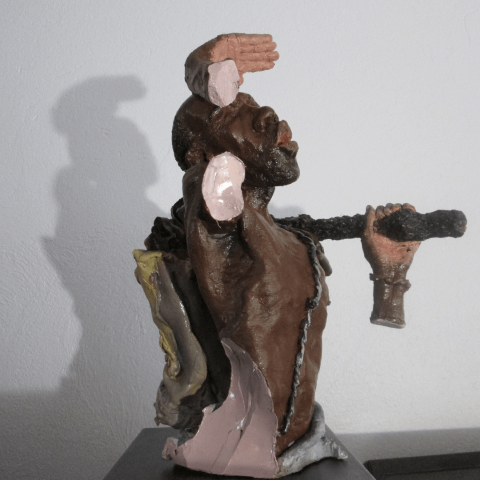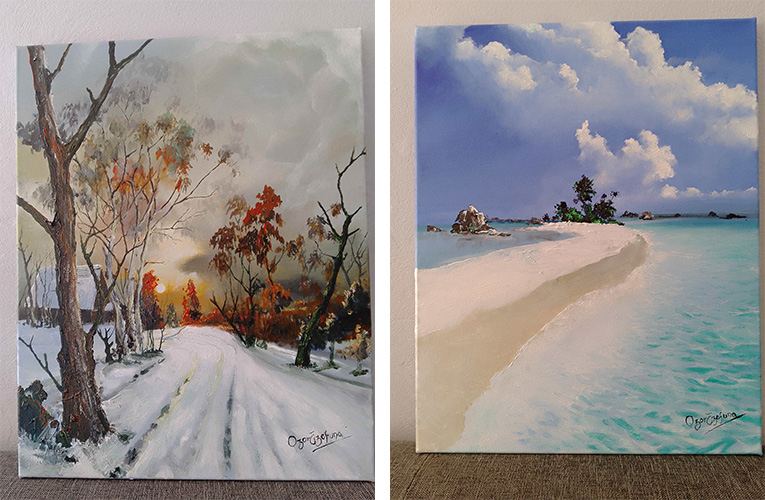Nigerian artist Ezefuna Ozor-Ejike’s sculpture Hunter is a metaphor of humankind’s exploitation of the planet
By Maricia Elizabeth Greyling
Ezefuna Ozor-Ejike’s the Hunter can be regarded as aesthetic abstraction. The resin sculpture’s void features echo an existential difficulty the rural African hunter is confronted with. This difficulty then relates to a growing sense of pessimism about wild life populations depleting, causing the hunter to experience prolonged periods without a catch. Resin both durable and versatile, is connected to the endurance and adaptable nature of the hunter himself. The hunter is resilient and strong as he needs to survive this strenuous environment.
The ‘Hunter’ is physically a hollow work of art which is accomplished through rotational casting. The method used speaks to the empty and weightless struggle of the hunter, a material depiction of the emotional and physical cost of a life characterised by scarcity, lack and uncertainty. The surface of the sculpture is hand painted and has been deliberately aged, reflecting this narrative through intentional variations in tonality. Tonality itself becomes representative of the hunter’s innate connection to an environment unforgiving. The intricate work of realising the ‘Hunter’ embodies the essence of the hunter’s life with an intentional blend of material and craftsmanship, evocative of a rich narrative.
The piece speaks to the hunter’s plight and endless search for game ever intensifying. It speaks about the hunter but it in a larger way relates to human existence. Ozor-Ejike contrasts the ‘Hunter’’s connection with the natural world to humanities growing disconnect with nature. Forests are devastated, marine life exhausted and wildlife numbers are dwindling. ‘Hunter’ then is emblematic of what our potential future holds.
The hunter, once enjoying plentiful game is left holding his sack, empty, under the unforgiving rays of the sun. Humankind is haunted by our own over consumption that has led to an irreversibility of the depleted natural resources of the earth. Like wildfires are all consuming and cause mass devastation, so has humanity done upon this earth.

‘Hunter’ can be regarded as a metaphor of humankind’s exploitation of the planet. However, the viewer is encouraged to consider their personal role in a shared dilemma. ‘Hunter’ advocates for a change in perception, asking for replenishment and balance before it is too late for the ecosystem to be repaired. Ozor-Ejike asks us with this piece, to be accountable.
In contrast with the warnings of the ‘Hunter’ we are met with moments for peaceful reflection in such acrylic on canvas works as ‘Beach Serene’ and ‘Flames of Winter’. Depth draws in their viewers arresting them momentarily in the artist’s use of immersive realism. These works reflects Ozor-Ejike’s belief that art is a powerful language with the capacity to express thoughts, feelings and ideas that language fails to evoke. ‘Beach Serene’ and ‘Flames of Winter’ aims to tell stories through visuality creating a space for reflection and connecting people on a deeply human level.
Ozor-Ejike has an immersive toolkit at his disposal, effortlessly navigating the world of the hyper real to the abstract. What connects his works is a seamless thread in purpose that speaks to humanity and our connection to the natural world. Sometimes as a critique, and at other times in works such as ‘Beach Serene’ and ‘Flames of Winter’ almost as the Romantics, with a deep respect and love for nature with the notion that the human is an integral part of the natural world.










